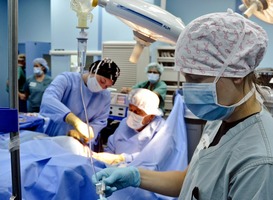The lungs of premature children are not yet finished. In addition, the lungs are often additionally damaged. This can already happen during pregnancy, for example due to an infection in the amniotic fluid. But damage can also occur after birth, for example due to infections or as a result of ventilation. “Because of all these events, these children have fewer reserves from the start,” says biologist and researcher at Maastricht University Tim Wolfs. “This makes them more likely to get lung diseases, such as bronchopulmonary dysplasia (BPD) and chronic obstructive pulmonary disease (COPD).” So far, there is no treatment that can repair the lung damage in these children. That is why Wolfs wants to investigate whether stem cells can adjust the development of the lungs.
Stem cells
Tim Wolfs conducts his research on premature lambs. “Their development resembles that of children, but after birth it is much faster. After half a year they enter puberty and after a year they are adults. This allows us to follow them from birth to adulthood in a short period of time.”
Wolfs treats some of the lambs with stem cells. Not another part. “We compare whether the lambs that receive stem cells do better than the lambs that do not. We are investigating this in different phases. When they are just born, when they grow up and when they are adults.”
Less oxygen needed
Wolfs already has results for the first phase. “We see that the lambs that receive stem cells need less extra oxygen in the first days after birth. In addition, the lungs also develop better. They produce more substances that ensure that better or new alveoli are created. Their immune system also works better than in lambs that have not received stem cells. You can see that because there is less inflammation in the lungs.”
Masker
“When the lambs get bigger, we measure their lung function. We do that just as we do with young children. We let them breathe through a mask for a short time. That is not harmful to the animals. Meanwhile, we measure the air that goes in and out of the lungs. If the lungs are damaged or less well developed, the air cannot enter as easily. We do not yet know whether there are real differences between the group that does and does not receive stem cells. We are currently investigating that.”
“I would also like to know how the various measurements are related. If the lungs work less well in the ‘baby phase’, is this also reflected in the lung function later in life? And in the lung tissue when the sheep is an adult? We will know this at the end of the investigation.”
Safe
It is of course great that the first results are so positive. But is the treatment also safe? “We can also look at that very closely in our research. During the research we follow the lambs from birth to adulthood. That gives us the opportunity to measure whether nothing really goes wrong, also in the long term.”
By: National Care Guide


